

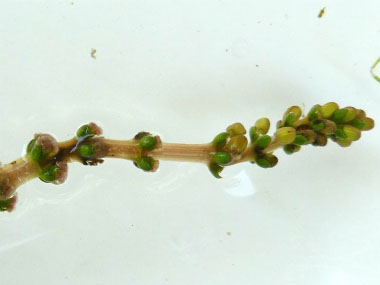
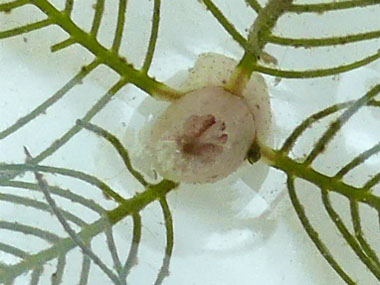

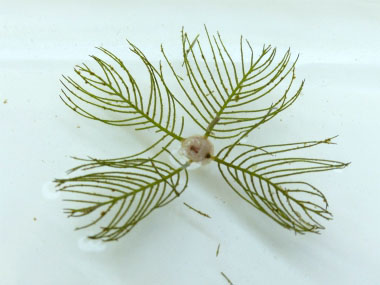
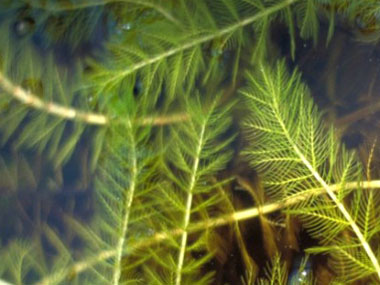
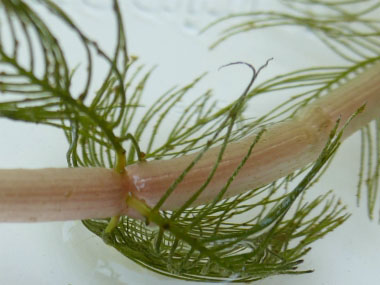
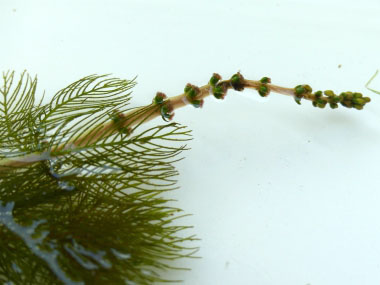
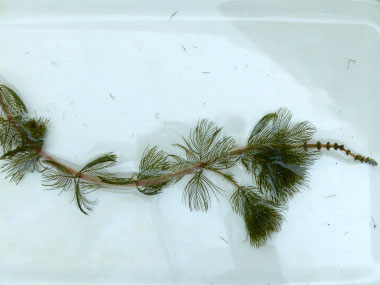
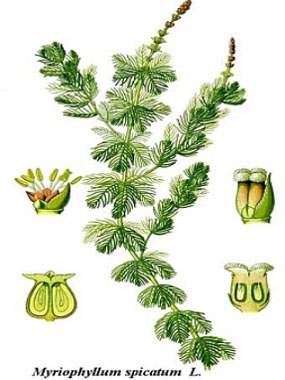
To support our efforts please browse our store (books with health benefits, etc.).
Eurasian watermilfoil is in the Haloragaceae family and is native to Europe, Asia and Northern Africa. It was discovered in the eastern United States in the early 1900s. The species was likely introduced and spread through the movement of watercraft and water-related equipment. Like other plants, Eurasian watermilfoil uses seeds to reproduce, but it also reproduces by broken fragments of the plant. These shoots are carried in water currents and spread easily. Milfoil is also spread by boats, motors, trailers, bilges, live wells, or bait buckets, and can stay alive for days if kept moist. Even though each plant can produce approximately 100 seeds per season, this species is more successful at reproducing via fragments.
Distinguishing Features
A fast-growing perennial aquatic plant, it forms dense underwater mats that shade other aquatic plants. Tips of the plant are sometimes red or pink in color. It is easily identified by its leaves. It has 12 to 21 pairs of leaflets per leaf which helps to distinguish it from the native northern watermilfoil. The native plant typically has 7 to 11 pairs of leaflets.
Flowers
A small pink flower spike up to four inches long produces tiny yellow flowers. Male and female flowers are found on the same plant.
 Fields
of Nutrition has medicinal benefits and vitamin/mineral content of Eurasian Watermilfoil.
Fields
of Nutrition has medicinal benefits and vitamin/mineral content of Eurasian Watermilfoil.
Leaves
Leaves are feather-like, with four leaves arranged in a whorl around the stem. Space between whorls along the stem can be 1cm (1/2”) or greater. Each leaf has a central axis with 12 to 21 leaflet pairs. Leaflets are limp when the plant is removed from the water.
Height
Eurasian watermilfoil prefers shallow water, 1 to 3 metres (3 to 9') deep, but can root in up to 10 metres (12') of water. It has thin stems that branch, and can be appear green, brown, or pinkish white. The stems get progressively thinner the further they grow from the main stem.
Habitat
This plant is found in places with lots of nutrients. It likes heavily used lakes, disturbed lake beds, and lakes that get a lot of nitrogen and phosphorous runoff. Warmer lakes can cause the milfoil to flower and reproduce more often in one summer. This aquatic plant is found throughout many areas in the US, Canada, the UK, Europe and other countries.
Edible Parts
According to Plants for a Future, the root can be eaten raw or cooked. It is said to be sweet and crunchy. NEVER harvest from polluted waters and always be aware of water quality as bacterial levels tend to increase in the summer months. Also, after heavy rains, e-coli and other bacteria levels may increase.
Other Name
Spiked Watermilfoil.
Similar Plants
Northern Watermilfoil.
Winter Survival Food Handbook

PDF Plant Magazines
Types of Wild Food
Geographic Zones Seasons
Disclaimer
EdibleWildFood.com is informational in nature. While we strive to be 100% accurate, it is solely up to the reader to ensure proper plant identification. Some wild plants are poisonous or can have serious adverse health effects.
We are not health professionals, medical doctors, nor are we nutritionists. It is up to the reader to verify nutritional information and health benefits with qualified professionals for all edible plants listed in this web site. Please click here for more information.
Why Edible Wild Food?
- Food costs are rising
- Free, wild food is readily abundant
- Wild food adds nutrition to your diet
- Wild food can help treat various medical conditions





